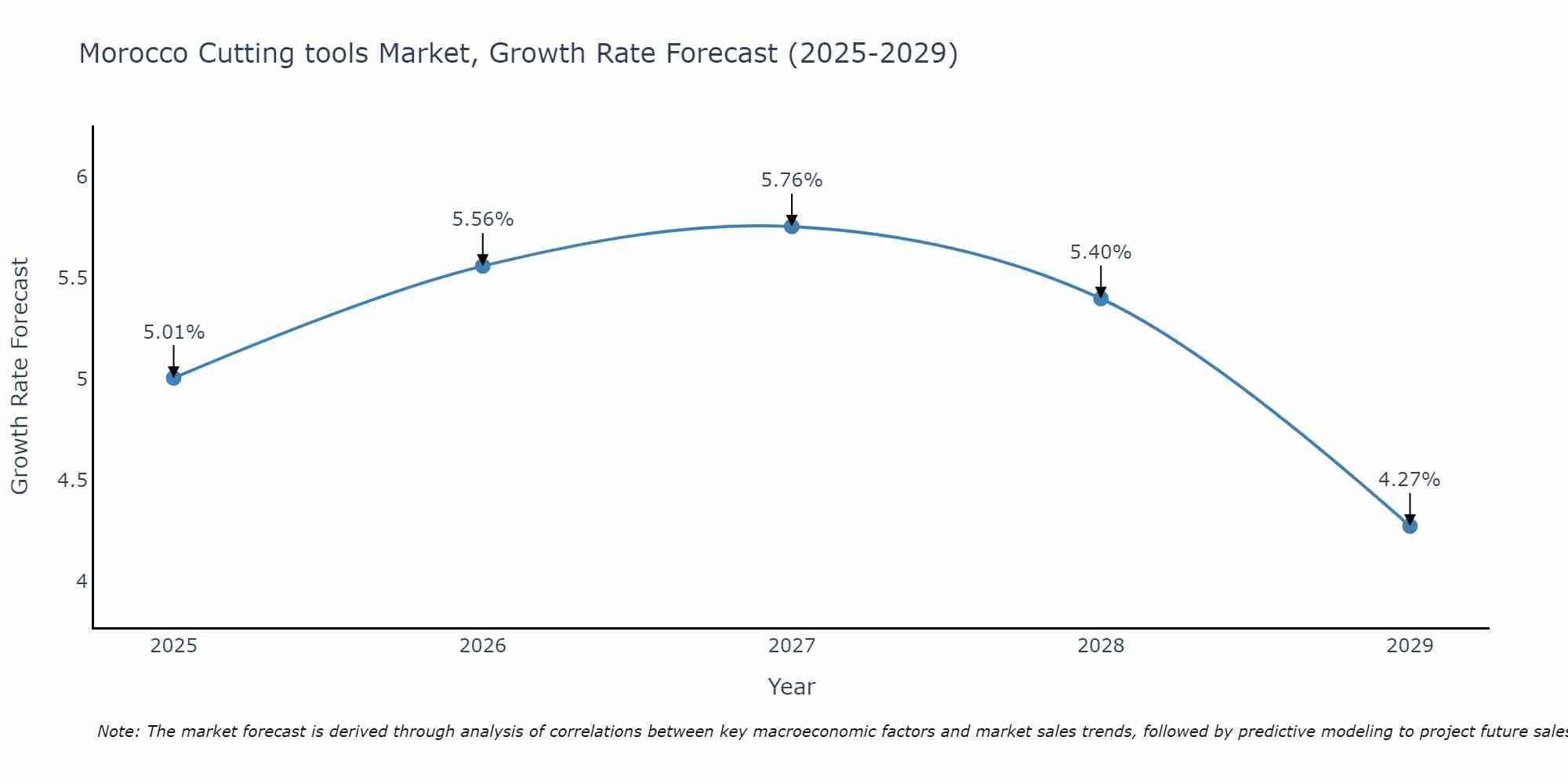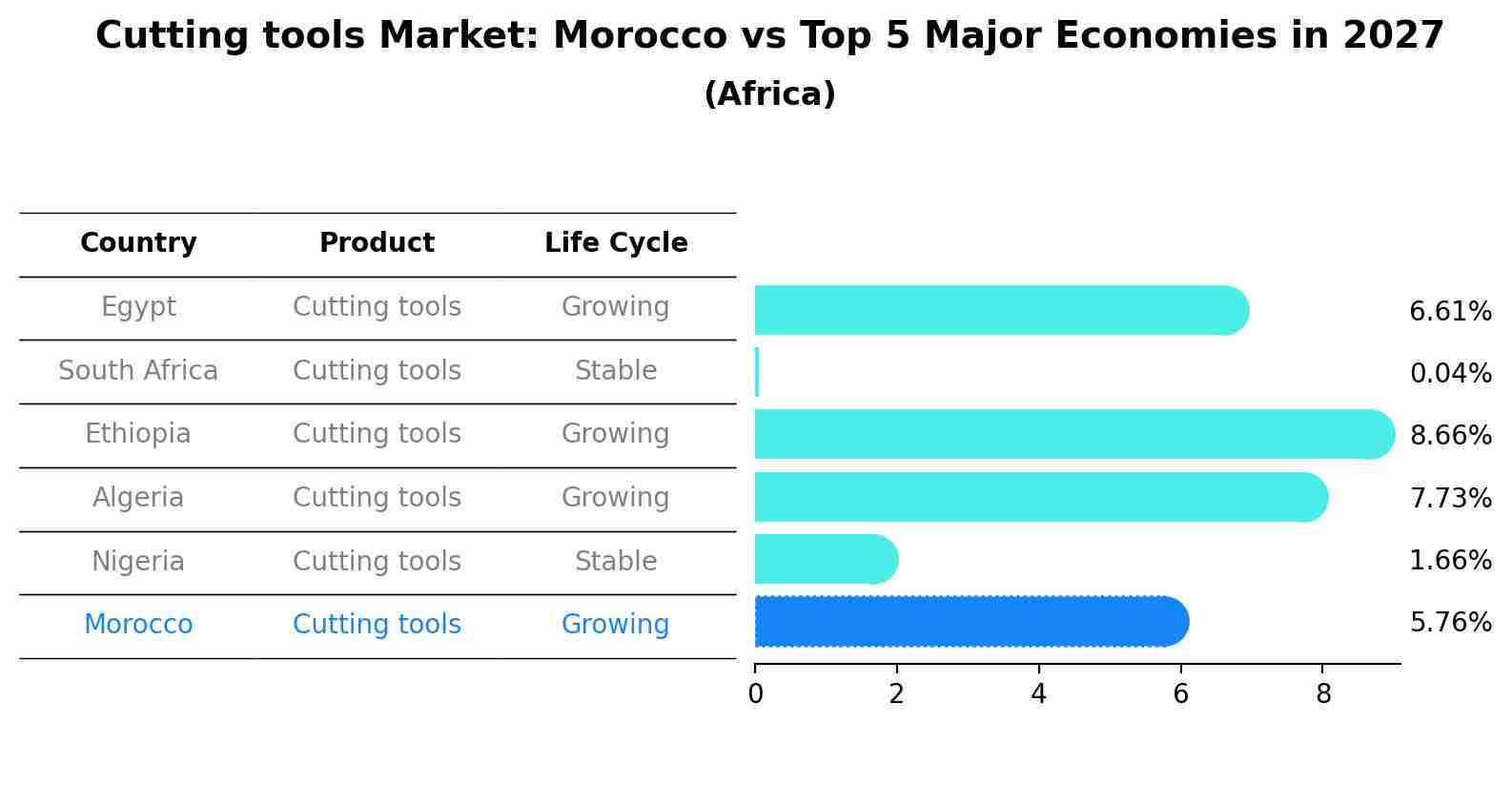Morocco Cutting tools Market (2025-2031) | Growth, Value, Revenue, Outlook, Companies, COVID-19 IMPACT, Analysis, Size, Forecast, Share, Industry & Trends
| Product Code: ETC022633 | Publication Date: Oct 2020 | Updated Date: Apr 2025 | Product Type: Report | |
| Publisher: 6Wresearch | Author: Ravi Bhandari | No. of Pages: 70 | No. of Figures: 35 | No. of Tables: 5 |
Morocco Cutting tools Market Size Growth Rate
The Morocco Cutting tools Market is projected to witness mixed growth rate patterns during 2025 to 2029. The growth rate begins at 5.01% in 2025, climbs to a high of 5.76% in 2027, and moderates to 4.27% by 2029.

Cutting tools Market: Morocco vs Top 5 Major Economies in 2027 (Africa)
In the Africa region, the Cutting tools market in Morocco is projected to expand at a growing growth rate of 5.76% by 2027. The largest economy is Egypt, followed by South Africa, Ethiopia, Algeria and Nigeria.

Morocco Cutting tools Market Synopsis
The cutting tools market in Morocco is witnessing robust growth supported by the expanding manufacturing and construction sectors. High demand for precision cutting tools, including drills, saws, and milling cutters, is driven by the need for efficient machining processes and superior product quality. Manufacturers are investing in research and development activities to introduce innovative cutting solutions that offer improved performance and durability.
Drivers of the market
The cutting tools market in Morocco is propelled by several factors including the growing industrialization, infrastructure development projects, and the expanding automotive and aerospace sectors. The demand for high-performance cutting tools with superior durability, precision, and efficiency is increasing among manufacturers to improve production processes and product quality. Furthermore, technological advancements such as the development of advanced materials and coatings are driving innovation and market growth.
Challenges of the market
In the cutting tools market, maintaining product quality and precision while adhering to stringent industry standards remains a key challenge for manufacturers in Morocco. Moreover, the market is susceptible to fluctuations in demand from end-user industries such as automotive, aerospace, and construction, thereby requiring agile production strategies to mitigate risks.
Government Policy of the market
The cutting tools market in Morocco is supported by government initiatives to develop the manufacturing sector. These include investment in technical education and vocational training to provide skilled labor. The government also offers tax incentives for companies that invest in advanced cutting tools and technologies, promoting innovation and efficiency in production processes.
Key Highlights of the Report:
- Morocco Cutting tools Market Outlook
- Market Size of Morocco Cutting tools Market, 2024
- Forecast of Morocco Cutting tools Market, 2031
- Historical Data and Forecast of Morocco Cutting tools Revenues & Volume for the Period 2021-2031
- Morocco Cutting tools Market Trend Evolution
- Morocco Cutting tools Market Drivers and Challenges
- Morocco Cutting tools Price Trends
- Morocco Cutting tools Porter's Five Forces
- Morocco Cutting tools Industry Life Cycle
- Historical Data and Forecast of Morocco Cutting tools Market Revenues & Volume By Technology for the Period 2021-2031
- Historical Data and Forecast of Morocco Cutting tools Market Revenues & Volume By Organic Light Emitting Diode (OLED) for the Period 2021-2031
- Historical Data and Forecast of Morocco Cutting tools Market Revenues & Volume By LCoS for the Period 2021-2031
- Historical Data and Forecast of Morocco Cutting tools Market Revenues & Volume By LCD for the Period 2021-2031
- Historical Data and Forecast of Morocco Cutting tools Market Revenues & Volume By DLP for the Period 2021-2031
- Historical Data and Forecast of Morocco Cutting tools Market Revenues & Volume By Application for the Period 2021-2031
- Historical Data and Forecast of Morocco Cutting tools Market Revenues & Volume By Milling for the Period 2021-2031
- Historical Data and Forecast of Morocco Cutting tools Market Revenues & Volume By Turning for the Period 2021-2031
- Historical Data and Forecast of Morocco Cutting tools Market Revenues & Volume By Drilling for the Period 2021-2031
- Historical Data and Forecast of Morocco Cutting tools Market Revenues & Volume By Other for the Period 2021-2031
- Historical Data and Forecast of Morocco Cutting tools Market Revenues & Volume By Tool Grade for the Period 2021-2031
- Historical Data and Forecast of Morocco Cutting tools Market Revenues & Volume By High Speed Steel for the Period 2021-2031
- Historical Data and Forecast of Morocco Cutting tools Market Revenues & Volume By Ceramics for the Period 2021-2031
- Historical Data and Forecast of Morocco Cutting tools Market Revenues & Volume By Cermets for the Period 2021-2031
- Historical Data and Forecast of Morocco Cutting tools Market Revenues & Volume By cBN/PcBN for the Period 2021-2031
- Historical Data and Forecast of Morocco Cutting tools Market Revenues & Volume By Diamond for the Period 2021-2031
- Historical Data and Forecast of Morocco Cutting tools Market Revenues & Volume By Type for the Period 2021-2031
- Historical Data and Forecast of Morocco Cutting tools Market Revenues & Volume By Indexable for the Period 2021-2031
- Historical Data and Forecast of Morocco Cutting tools Market Revenues & Volume By Solid for the Period 2021-2031
- Morocco Cutting tools Import Export Trade Statistics
- Market Opportunity Assessment By Technology
- Market Opportunity Assessment By Application
- Market Opportunity Assessment By Tool Grade
- Market Opportunity Assessment By Type
- Morocco Cutting tools Top Companies Market Share
- Morocco Cutting tools Competitive Benchmarking By Technical and Operational Parameters
- Morocco Cutting tools Company Profiles
- Morocco Cutting tools Key Strategic Recommendations
Frequently Asked Questions About the Market Study (FAQs):
1 Executive Summary |
2 Introduction |
2.1 Key Highlights of the Report |
2.2 Report Description |
2.3 Market Scope & Segmentation |
2.4 Research Methodology |
2.5 Assumptions |
3 Morocco Cutting tools Market Overview |
3.1 Morocco Country Macro Economic Indicators |
3.2 Morocco Cutting tools Market Revenues & Volume, 2021 & 2031F |
3.3 Morocco Cutting tools Market - Industry Life Cycle |
3.4 Morocco Cutting tools Market - Porter's Five Forces |
3.5 Morocco Cutting tools Market Revenues & Volume Share, By Technology , 2021 & 2031F |
3.6 Morocco Cutting tools Market Revenues & Volume Share, By Application , 2021 & 2031F |
3.7 Morocco Cutting tools Market Revenues & Volume Share, By Tool Grade, 2021 & 2031F |
3.8 Morocco Cutting tools Market Revenues & Volume Share, By Type , 2021 & 2031F |
4 Morocco Cutting tools Market Dynamics |
4.1 Impact Analysis |
4.2 Market Drivers |
4.3 Market Restraints |
5 Morocco Cutting tools Market Trends |
6 Morocco Cutting tools Market, By Types |
6.1 Morocco Cutting tools Market, By Technology |
6.1.1 Overview and Analysis |
6.1.2 Morocco Cutting tools Market Revenues & Volume, By Technology , 2021-2031F |
6.1.3 Morocco Cutting tools Market Revenues & Volume, By Organic Light Emitting Diode (OLED), 2021-2031F |
6.1.4 Morocco Cutting tools Market Revenues & Volume, By LCoS, 2021-2031F |
6.1.5 Morocco Cutting tools Market Revenues & Volume, By LCD, 2021-2031F |
6.1.6 Morocco Cutting tools Market Revenues & Volume, By DLP, 2021-2031F |
6.2 Morocco Cutting tools Market, By Application |
6.2.1 Overview and Analysis |
6.2.2 Morocco Cutting tools Market Revenues & Volume, By Milling, 2021-2031F |
6.2.3 Morocco Cutting tools Market Revenues & Volume, By Turning, 2021-2031F |
6.2.4 Morocco Cutting tools Market Revenues & Volume, By Drilling, 2021-2031F |
6.2.5 Morocco Cutting tools Market Revenues & Volume, By Other, 2021-2031F |
6.3 Morocco Cutting tools Market, By Tool Grade |
6.3.1 Overview and Analysis |
6.3.2 Morocco Cutting tools Market Revenues & Volume, By High Speed Steel, 2021-2031F |
6.3.3 Morocco Cutting tools Market Revenues & Volume, By Ceramics, 2021-2031F |
6.3.4 Morocco Cutting tools Market Revenues & Volume, By Cermets, 2021-2031F |
6.3.5 Morocco Cutting tools Market Revenues & Volume, By cBN/PcBN, 2021-2031F |
6.3.6 Morocco Cutting tools Market Revenues & Volume, By Diamond, 2021-2031F |
6.4 Morocco Cutting tools Market, By Type |
6.4.1 Overview and Analysis |
6.4.2 Morocco Cutting tools Market Revenues & Volume, By Indexable, 2021-2031F |
6.4.3 Morocco Cutting tools Market Revenues & Volume, By Solid, 2021-2031F |
7 Morocco Cutting tools Market Import-Export Trade Statistics |
7.1 Morocco Cutting tools Market Export to Major Countries |
7.2 Morocco Cutting tools Market Imports from Major Countries |
8 Morocco Cutting tools Market Key Performance Indicators |
9 Morocco Cutting tools Market - Opportunity Assessment |
9.1 Morocco Cutting tools Market Opportunity Assessment, By Technology , 2021 & 2031F |
9.2 Morocco Cutting tools Market Opportunity Assessment, By Application , 2021 & 2031F |
9.3 Morocco Cutting tools Market Opportunity Assessment, By Tool Grade, 2021 & 2031F |
9.4 Morocco Cutting tools Market Opportunity Assessment, By Type , 2021 & 2031F |
10 Morocco Cutting tools Market - Competitive Landscape |
10.1 Morocco Cutting tools Market Revenue Share, By Companies, 2024 |
10.2 Morocco Cutting tools Market Competitive Benchmarking, By Operating and Technical Parameters |
11 Company Profiles |
12 Recommendations |
13 Disclaimer |
- Single User License$ 1,995
- Department License$ 2,400
- Site License$ 3,120
- Global License$ 3,795
Search
Thought Leadership and Analyst Meet
Our Clients
Related Reports
- Canada Oil and Gas Market (2026-2032) | Share, Segmentation, Value, Industry, Trends, Forecast, Analysis, Size & Revenue, Growth, Competitive Landscape, Outlook, Companies
- Germany Breakfast Food Market (2026-2032) | Industry, Share, Growth, Size, Companies, Value, Analysis, Revenue, Trends, Forecast & Outlook
- Australia Briquette Market (2025-2031) | Growth, Size, Revenue, Forecast, Analysis, Trends, Value, Share, Industry & Companies
- Vietnam System Integrator Market (2025-2031) | Size, Companies, Analysis, Industry, Value, Forecast, Growth, Trends, Revenue & Share
- ASEAN and Thailand Brain Health Supplements Market (2025-2031) | Strategy, Consumer Insights, Analysis, Investment Trends, Opportunities, Growth, Size, Share, Industry, Revenue, Segments, Value, Segmentation, Supply, Forecast, Restraints, Outlook, Competition, Drivers, Trends, Demand, Pricing Analysis, Competitive, Strategic Insights, Companies, Challenges
- ASEAN Bearings Market (2025-2031) | Strategy, Consumer Insights, Analysis, Investment Trends, Opportunities, Growth, Size, Share, Industry, Revenue, Segments, Value, Segmentation, Supply, Forecast, Restraints, Outlook, Competition, Drivers, Trends, Demand, Pricing Analysis, Competitive, Strategic Insights, Companies, Challenges
- Europe Flooring Market (2025-2031) | Outlook, Share, Industry, Trends, Forecast, Companies, Revenue, Size, Analysis, Growth & Value
- Saudi Arabia Manlift Market (2025-2031) | Outlook, Size, Growth, Trends, Companies, Industry, Revenue, Value, Share, Forecast & Analysis
- Uganda Excavator, Crane, and Wheel Loaders Market (2025-2031) | Strategy, Consumer Insights, Analysis, Investment Trends, Opportunities, Growth, Size, Share, Industry, Revenue, Segments, Value, Segmentation, Supply, Forecast, Restraints, Outlook, Competition, Drivers, Trends, Demand, Pricing Analysis, Competitive, Strategic Insights, Companies, Challenges
- Rwanda Excavator, Crane, and Wheel Loaders Market (2025-2031) | Strategy, Consumer Insights, Analysis, Investment Trends, Opportunities, Growth, Size, Share, Industry, Revenue, Segments, Value, Segmentation, Supply, Forecast, Restraints, Outlook, Competition, Drivers, Trends, Demand, Pricing Analysis, Competitive, Strategic Insights, Companies, Challenges
Industry Events and Analyst Meet
Whitepaper
- Middle East & Africa Commercial Security Market Click here to view more.
- Middle East & Africa Fire Safety Systems & Equipment Market Click here to view more.
- GCC Drone Market Click here to view more.
- Middle East Lighting Fixture Market Click here to view more.
- GCC Physical & Perimeter Security Market Click here to view more.
6WResearch In News
- Doha a strategic location for EV manufacturing hub: IPA Qatar
- Demand for luxury TVs surging in the GCC, says Samsung
- Empowering Growth: The Thriving Journey of Bangladesh’s Cable Industry
- Demand for luxury TVs surging in the GCC, says Samsung
- Video call with a traditional healer? Once unthinkable, it’s now common in South Africa
- Intelligent Buildings To Smooth GCC’s Path To Net Zero


















